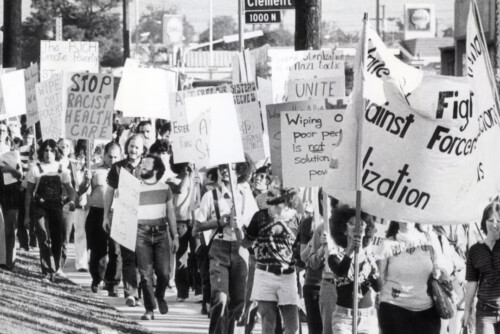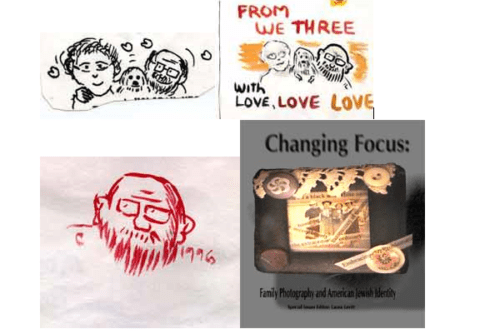The Film
Excerpt from the documentary No Más Bebés Por Vida, directed by Renee Tajima-Peña and produced by Virginia Espino and Renee Tajima-Peña, in association with the Independent Television Service and Latino Public Broadcasting.
The setting of No Más Bebés Por Vida is the largely Mexican-American community on the east side of Los Angeles. The massive Beaux Arts buildings that originally housed LAC+USC sit atop a hilly rise in the Boyle Heights neighborhood. Now shuttered beside a newly built facility, the old structure was known during the 1970s as the setting of the soap opera General Hospital. In 1973, the real LAC+USC was a huge public hospital serving many working-class, low income, and immigrant populations. At the complex’s Women’s Hospital, a young intern, Dr. Bernard Rosenfeld, became alarmed at practices inside the maternity ward. He believed that women of Mexican origin were being sterilized without their knowledge or consent, and set about to surreptitiously gather evidence from hospital records. After his shifts, Rosenfeld would spend hours typing out letters to journalists, civil rights groups, government offices, and national politicians. He hoped that the evidence he collected would bring legislative mandates to protect women from future abuse and would lead to legal retribution for the victims.
Finally, the case was taken on by a group of young Mexican American lawyers at the nearby storefront legal organization, the Model Cities Center for Law and Justice. Twenty-six-year-old Antonia Hernandez was just out of the UCLA School of Law when she and Charles Nabarrete, an attorney, were contacted by Dr. Rosenfeld. Hernandez had grown up on the east side of Los Angeles, and her own mother had been pressured at LAC+USC to agree to sterilization when she gave birth to her youngest daughter. The two young lawyers agreed to mount a class action lawsuit (Georgina Torres-Risk was initially co-counsel) in conjunction with the Chicana feminist organization Comisión Feminil, led at the time by a young legal secretary named Gloria Molina. 1 Ten local women agreed to sign on as plaintiffs, and the civil rights lawsuit Madrigal v. Quilligan was filed in federal court against the US Department of Health, Education and Welfare; the California State Department of Health; the individual doctors who had performed sterilizations; the chief resident Dr. Roger Freeman, and Dr. Edward J. Quilligan. A local attorney, Ricardo Cruz, filed a related private lawsuit on behalf of three women sterilized at the hospital, Andrade v. Los Angeles County.
The interviews that we filmed for the documentary reveal conflicting accounts of the sterilizations. Women have vivid memories of coercive practices by medical staff. Dolores Madrigal, a factory worker and mother of two, who would become lead plaintiff in the lawsuit, was assured that her tubes could be “untied” later. Other women such as plaintiff Jovita Rivera, who was sterilized at the age of 27, were never informed that they could no longer bear children. On the other hand, doctors at the hospital refute the charges of coercion, and insist that reproductive research and patient care thrived under the leadership of Dr. Quilligan, at the time one of the most esteemed obstetrical researchers in the world. The framework of reproductive justice—and its intersectionality with immigration, race, gender, and poverty—complicates the narrative of sterilizations at LAC+USC. The medical staff functioned in a massive public hospital, delivering over 1,000 babies per month with no clear protocol for informed consent. From newly minted young residents just out of school to marquee names in research, doctors performed and presided over the sterilizations and, at the same time, participated in groundbreaking advances for women’s reproductive health. In this golden age of family planning, federal funding made contraception accessible and affordable to women at all income levels. Poor, predominantly Mexican-origin women at LAC+USC simultaneously benefited from or were unwillingly subjected to contraceptive procedures and testing.
The recognition of the intersectionalities underlying the notion of reproductive justice was implicit to the mobilization around the case by Chicana feminists. Their resistance to sterilization abuse magnified underlying contradictions both within the male-dominated nationalist movement that rendered female autonomy secondary, and among mainstream feminists who privileged the concerns of middle-class, white women. As in Dorothy Roberts’ insistence on calculating race and African American women’s experience into any equation of reproductive liberty, 2 the anti-sterilization abuse movement was intricately tied to the emergence and definition of Chicana feminism. Activists organizing against racially based pro-sterilization views argued that women had a basic human right to bear a child. That position helped to distinguish them from white feminists whose focus on abortion rights during the same period often made them oblivious to the reproductive abuse faced by women of color throughout the United States. The California chapter of the National Organization of Women opposed the call for a waiting period for sterilizations as a threat to abortion and sterilization on demand; some radical feminists refused to participate in any action involving men. 3
A Filmmaker’s Note on the Social Documentary Approach
First, I would like to state what may sound obvious, but that sometimes gets murky in the actual practice of artistic and scholarly collaboration: a film is not a text; artistic labor and academic labor are different—in processes, in constituencies, and often in temperaments. But there is much work to be done together. In the Social Documentation Program (SocDoc) at the University of California, Santa Cruz and the EthnoCommunications Program that I will soon join at UCLA, we teach a filmmaking practice that merges social scientific and humanities theories and analyses with documentary. This does not assume expert testimony or data graphics on screen. Rather, this is a methodology that embeds research and ideas into the DNA of the film: a bit of alchemy, a lot of trust.
No Más Bebés Por Vida came out of that documentary practice, which I have relied on ever since my first film, Who Killed Vincent Chin? As noted above, the origin story of the film began with research into the LAC+USC case by the film’s co-producer, Virginia Espino, who conducted formative primary research into the case. She and I are neighbors, and she often talked about her project during playdates when our kids were small. The story hit me in the gut. I was a new mother; the idea that my fertility, my dreams, could be crushed at this moment of profound vulnerability, was unfathomable. At the time, I was working on two films that similarly traversed the landscape of mourning and dislocation of migration and poverty. For The New Americans: Mexico Story, I filmed the story of a migrant Kansas meatpacker named Pedro Flores who only had one shot at finally bringing his family to the United States after 13 years of separation. 4 Calavera Highway followed my husband Armando Peña, who grew up a farmworker, as he retraced the migrant trail to carry his mother’s ashes back home and reunite with his far-flung brothers. The tenor of loss, poverty, and injustice, is nothing new for a documentary filmmaker. But after over 25 years of making films, I was more and more flummoxed. How to speak to the unspeakable?
As a creative work, No Más Bebés Por Vida, then, is a search for a visual language and a deeper comprehension of making legible that “presence of absence.” How can a film express the true dimensions of violation and its aftermath, whether inconsolable or transformational, given the extent to which these internal processes are not visible to the camera? How can migration and work; dislocation and war; childbirth and death; and love and loss link the private and the public? And finally, as Judith Butler asks, “who counts as human?” 5
As I entered the rooms and hallways of the abandoned hospital with my film crew, the site conjured the traces of the almost unknowable lived experience of the women who were sterilized. It is haunted, but not by the ghouls and phantoms of the popular imagination. Avery Gordon, Rosalinda Fregoso, and others maintain that there is a politics to these kinds of metaphorical hauntings. For Gordon, the ghosts appear to us when there is unfinished business and they insist that we take notice “out of concern for justice.” These are the shadowed landscapes, the interstitial but essential stuff of the human condition that exists outside the grasp of empirical knowledge or language. 6 In making No Más Bebés Por Vida, I have drawn on the social documentary method, histories, literary texts, photography, and fiction film as a way of locating these traces, as in Alex Rivera’s film Sleep Dealer—a brilliant imagining of the other end of the nativist dream, that is, a future of Mexican labor disembodied from Mexican bodies; as in Toni Morrison’s novel, Beloved, and its central figure of a murdered child; and as in the photography of Carrie Mae Weems and Lorna Simpson, especially The Water Bearer, a figure bearing life in a simple white shift that at the same time conjures a shroud.
While filming the women who were plaintiffs of Madrigal v. Quilligan, white garments sometimes haunted the screen: Maria Hurtado beading her granddaughter’s wedding veil; the baptism of Maria Figueroa’s grandson in the waters of the inexplicably named Mother’s Beach, the folding and unfolding of a christening dress. As Patricia Zavella pointed out to me, the imagery of figures in white evokes a re/visioning of the La Llorona myth—a woman blamed for the death of her child—but in this instance, the fault lies elsewhere, and the mothers declare the perpetrator. In the film, children are everywhere, most often seen in fleeting glimpses that summon forth the interior lives of the mothers. I see this as a transgressive appropriation of pro-life iconography. Chicana activists battled within the feminist movement to redefine choice as the right to abortion and the right to give birth.
The Madrigal v. Quilligan story culminated when ten sterilized mothers finally had their day in federal district court in 1978, leading to the surprising fate of the case. The legacy of that battle still lives on in the emergence of those Chicana leaders both at a grassroots level and in mainstream politics, and not only in the contentious issues surrounding immigrants, access to public benefits, and health care, but in the transformed political landscape for Mexican Americans to intervene in those debates. It is a legacy that is most profoundly named and inscribed on pages of court documents and memory: Guadalupe Acosta, Estella Benavides, Maria Figueroa, Rebecca Figueroa, Maria Hurtado, Consuelo Hermosillo, Georgina Hernandez, Dolores Madrigal, Helena Orozco, Jovita Rivera.
- Antonia Hernandez went on to become the president of the Mexican American Legal Defense Fund and is currently the president and CEO of the California Community Foundation, Charles Nabarette is an administrative law judge, and Georgina Torres-Rizk is a superior court judge. Ironically, Gloria Molina is a long-time Los Angeles County supervisor and journalist Frank Cruz, who covered the trial, is a member of the board of trustees at USC, both in positions of power at the institutions governing the medical center.[↑]
- Dorothy Roberts, Killing the Black Body: Race, Reproduction, and the Meaning of Liberty, (New York: Vintage Books, 1997).[↑]
- Espino 2000.[↑]
- Part of a seven-hour series for PBS, The New Americans, produced by Kartemquin Films.[↑]
- Judith Butler, “Violence, Mourning, Politics,” Studies in Gender and Sexuality, 4.1 (2003) 9-37.[↑]
- Avery Gordon, Ghostly Matters: Haunting and the Sociological Imagination, (Minneapolis: U of Minnesota P, 1997).[↑]




